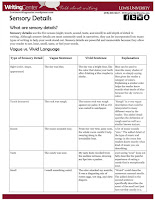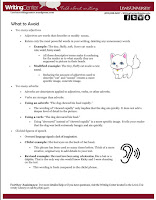The First Rule of Writing: Show, Don’t Tell for the Novice Writer
"Don’t tell me the moon is shining; show me the glint of light on broken glass."
– Anton Chekhov
“Show, Don’t Tell” is an important rule when it comes to writing your story, it is the magic technique that breathes life and energy into any story.
The single best piece of advice you can receive to become a good writer is “Don’t tell me, show me.” Don’t tell me the character is angry; show me that the character is angry. Don’t tell me that the character had a good time at the party; show me how the character had a good time. This is The First Rule of Writing.
Telling sentences tell us something. They give information but it is general, non‐specific, and often vague. They don’t involve the reader. Telling sentences are written in a dull and lifeless manner. You leave out the action, emotion, and sensory detail — all the vital ingredients that make the reader believe in your story. “Telling” is a way of communicating facts to the reader — the wrong way. The right way is to “show” information through the use of action, dialogue, and the five senses. (If you’re still confused, please read on and let me “show” you what I mean.)
Imagine yourself in a darkened movie theater. All of a sudden the screen goes black and you can hear only the sound track — the dialogue and a few sound effects. How frustrated you’d be! If the technician didn’t get the projector fixed fast, you’d get bored and leave. The same is true for writing. If you fail to make the reader see your story, she’ll lose interest, put down the book, and never pick it up again. If that reader happens to be the editor to whom you’ve submitted your manuscript, then you’ve lost a sale.
Showing sentences show us — they describe the scenes and actions; they help us see by using clear, specific details to create clear, strong pictures in our minds. Showing sentences dramatize the events of your plot. The reader experiences the story as if he’s right there, participating in the story. In his imagination, he becomes the character. A showing sentence has a different “sound” and “feeling” when you read it.
Look at the following examples:
1) First Example
Telling sentence: Jack was afraid.
Showing sentence: As the footsteps tapped closer and closer, Jack felt his stomach muscles tighten. He flattened himself to the wall, the gritty bricks against his cheek. Sweat chilled his palms. He used both hands to steady the gun.
Telling Sentences Give Information
Notice in the “telling” sentence, we’re given information, but in a way that doesn’t involve us in any scene. It’s as if we’re sitting in that movie theater, staring at a black screen and growing increasingly annoyed by our inability to see what’s happening.
In the “showing” sentence, however, we live through the scene along with Jack. We hear the tap of footsteps. We feel the tension in his stomach, the cold dampness of his hands, and the grittiness of the brick. We see the gun in his shaking hands. We live his fear, rather than merely being told of it.
And along the way, something miraculous happens: Jack becomes a real person. Even if he’s the bad guy, we can identify with him because we experience his fear, and fear is a universal human emotion. We want to turn the page and find out what happens to Jack. This is the power of “showing” instead of “telling.”
The Secret to “Showing” a Scene
So what is the secret to “showing” a scene? It’s beautifully simple. Use specific details. Specific details breathe life into your story. They stimulate the reader’s imagination so he can project himself into the scene and become a part of it. By the way, watch out whenever you name an emotion, such as Jack was afraid. It’s lazy writing. The reader won’t feel the emotional impact. How much better it is to “show” the emotion through action, the five senses, and dialogue.
2) Second Example
Telling sentence: Dave thought Brenda was acting secretive.
Showing sentence: Brenda slammed his dresser drawer shut and spun around, her hands hidden behind her back. Her lips jerked into a stiff smile. “Dave! I‐I thought you wouldn’t be home until six o’clock.”
Showing Brings a Vivid Picture
The “showing” example uses physical action, facial expression, and dialogue to convey the same information as the “telling” sentence. But with “showing,” we get a vivid picture. We watch the scene as if it were playing on a movie screen.
So, “showing” makes a scene come alive through the use of details. So take a good, close look at how you present your ideas and characters. All good books touch the reader on an emotional level. You do so by giving proof to the reader — proof of how this character acts and reacts when faced by problems. In other words, you “show” the reader why we should cheer for the character or boo him. And hopefully, in the process, readers will find themselves drawn into the story, unable to put the book down.
So now you have the idea, right? We need details. We need to know thoughts, feelings; we need to see, hear, feel, smell and taste your story. Learn how to put details in your writing. Did you ever wonder why you remember the characters in a book? Or what made a story especially memorable? By combining many elements of writing, you can learn how to write good stories and essays. You have to use the senses, avoid boring dialogue, and write memorable descriptions.
3) Third Example
Telling sentence: Mary was a pretty girl, with blue eyes and blond hair.
Showing sentence: Mary’s blue eyes glistened with joy, her blond hair bouncing with each step.
4) Fourth Example
Telling sentence: Molly is a wonderful person.
Showing sentence: Molly is always there when anyone needs her. She’s the first to arrive with a casserole when someone is sick, the first to send a note of encouragement to those who are troubled, the first to offer a hug to anyone ‐‐ man, woman or child ‐‐ at anytime.
5) Fifth Example
Telling sentence: It was very dark inside.
Showing sentence: I held my hand in front of my eyes but couldn’t see its outline. The walls were invisible and it was impossible to see the bottom of the steep stairs.
6) Sixth Example
Telling sentence: The pizza was delicious.
Showing sentence: Mushrooms and pepperoni sausage were layered thickly on top of one another while the white mozzarella cheese bubbled over the bright red tomato sauce.
7) Seven Example
Telling sentence: The house was haunted.
Showing sentence: The old house stood eerily abandoned on the hill, scaring everyone in the neighborhood with creaking, breathing noises.
8) Eight Example
Telling sentence: Eating healthy is good for your body.
Showing sentence: The calcium in milk, cheese, yogurt, and other dairy products, the vitamins in vegetables, and the protein in meal all help to keep our bodies strong and healthy.
9) Ninth Example
Telling sentence: I was really mad.
Showing sentence: I ran to the door, threw it open with a loud bang against the wall, and yelled, “Get in this house right this minute! You are three hours late!”
10) Tenth Example
Telling sentence: Jim was so angry that Blair was afraid.
Showing sentence: Jim grabbed the front of Blair’s shirt and slammed him into the wall. Blair fought to breathe, his heart hammering.
11) Eleventh Example
Telling sentence: The weather was bad.
Showing sentence: A harsh wind whipped through the trees. Dark clouds poured buckets of rain that overran the gutters and spilled onto the sidewalks.
DRAW the readers in; MAKE them a part of what is happening. SHOW the scene, GET them involved, GIVE it a dramatic impact, SHOW them what’s happening now or how things happened by painting your narrative with words. USE figurative language (similes and metaphors), dialogue and descriptive words.










